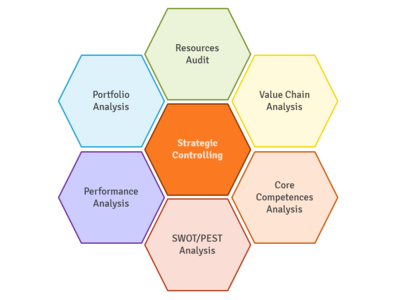Strategic controlling: Difference between revisions
(Infobox update) |
m (→Tasks) |
||
| Line 21: | Line 21: | ||
==Tasks== | ==Tasks== | ||
[[File:strategic_controlling.png|400px|right|thumb|Fig.1. Strategic controlling key elements]] | |||
The tasks of strategic controlling are: | The tasks of strategic controlling are: | ||
* Analysis of the feasibility of long-term corporate goals | * Analysis of the feasibility of long-term corporate goals | ||
| Line 31: | Line 33: | ||
* Determining the deviations from planned results, broken down by relevant/irrelevant and dependent/independent | * Determining the deviations from planned results, broken down by relevant/irrelevant and dependent/independent | ||
* Assistance in designing the necessary measures for correction of goals, elimination of interference from [[environment]] and adapting the environment to the [[strategic objectives]] | * Assistance in designing the necessary measures for correction of goals, elimination of interference from [[environment]] and adapting the environment to the [[strategic objectives]] | ||
==Features== | ==Features== | ||
Revision as of 16:02, 31 August 2020
| Strategic controlling |
|---|
| See also |
During strategic controlling process decisions are made on major issues related to what the company should do to achieve its goals. It involves monitoring, analysis and evaluation processes to direct company's course in the right direction.
The concept of strategic controlling was created in order to develop strategic planning capabilities, proper management tasks assignment, control of the process of their implementation and monitoring of results.
Strategic controlling creates the conditions for ensuring long-term existence and development of the company and generate new potential profits
Tasks
The tasks of strategic controlling are:
- Analysis of the feasibility of long-term corporate goals
- Tests for the correctness of the division of tasks into phases
- Assistance in selecting methods, techniques, standards and other tools that are applicable in the planning and control
- Assistance in the development and oversight of strategic plans
- Assistance in creating an managerial information system
- Monitoring of quality of information sources
- Conducting a pre-emptive monitoring and evaluation of options, opportunities and threats
- Determining the deviations from planned results, broken down by relevant/irrelevant and dependent/independent
- Assistance in designing the necessary measures for correction of goals, elimination of interference from environment and adapting the environment to the strategic objectives
Features
Strategic controlling has the following features:
- Is based on strategic plans
- Is based on the strategic management methods and techniques
- Uses methods of determining the deviation of strategic indicators,
- Provides information for long-term decisions, with the time horizon of more than one year.
Design stages of strategic controlling system
- Define the scope, field and time horizon.
- Preparation - review of objectives and strategic plans for the company.
- Selection of the control parameters and indicators.
- Providing information - an appropriate set of data, selection and processing methods, and rapid flow of information.
- Creating procedures for determining the control parameters and deviations. Selection of specific methods of calculation regarding time horizon and area of measurement.
- Define the principles and structure of decision-making process.
- Verify the operation of the designed system with adjustment, adaptation and improvement.
- Decision to implement the improved system
- Define a detailed schedule of implementation and preparation of necessary financial resources.
Strategic controlling uses various methods and organizational techniques. Very important is the selection of tools for building a solid base for planning function. Since strategic controlling concerns for a long period of time, the uncertainty of this processes is very large.
See also:
References
- Asch, D. (1992). Strategic control: A problem looking for a solution. Long Range Planning, 25(2), 105-110.
- Bungay, S., & Goold, M. (1991). Creating a strategic control system. Long range planning, 24(3), 32-39.
- Hill, C., Jones, G., & Schilling, M. (2014). Strategic management: theory: an integrated approach. Cengage Learning.
- Lorange, P., Morton, M. S. S., & Ghoshal, S. (1986). Strategic control systems. West Group.
- Mintzberg, H. (1990). The design school: reconsidering the basic premises of strategic management. Strategic management journal, 11(3), 171-195.
- Pearce, J. A., Robinson, R. B., & Subramanian, R. (2000). Strategic management: Formulation, implementation, and control. Columbus, OH: Irwin/McGraw-Hill.
